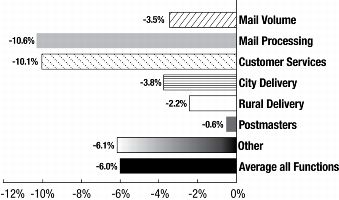Managers continue to improve their use of data to better align staffing with changing workload. There were 583,908 career employees at the end of 2010, which is 39,220 fewer than last year. There were also 87,779 noncareer employees. Reductions occurred in bargaining and nonbargaining categories and managers continue to plan for steady employee attrition by repositioning employees based on current and future resource requirements.
Approximately 75 million work hours were saved in 2010. This is in addition to 115 million hours reduced the previous year, 50 million hours in 2008, and 36 million hours in 2007. Over four years, the Postal Service achieved a total reduction of 276 million work hours, the equivalent of 157,000 full-time employees.
In customer service operations, scheduling improvements were the lead factor in saving 18 million work hours. In city delivery, 1,108 routes were eliminated, in addition to pivoting open routes and managing work hour variances, which contributed to savings of 16 million work hours. The number of delivery vehicles and related support costs were also reduced.
Mail Volume and Work Hour Reductions Change from 2009

The Postal Service continuously monitors and adapts its processing and transportation networks to changing customer mailing patterns and mail volume fluctuations. For example, the volume of stamped Single-Piece First-Class Mail, which requires a high degree of processing, declined. In the same period, presorted First-Class Mail volumes decreased 3.8 percent. Ongoing adjustments to such changes are essential to maintaining optimal performance.
In December 2009, the Postal Service provided Congress with an annual update of the Network Plan, as required by the Postal Act. The plan highlighted three integrated elements of the optimization effort: closure of airport mail centers (AMCs), consolidation of redundant mail processing operation, and transformation of the bulk mail center (BMC) network. Two of the three efforts were completed in 2010 and the third — consolidation of redundant mail processing operations — is an ongoing effort.
The last AMC was closed in 2010, with operations relocated to other facilities. The other 12 AMC locations were reclassified as processing centers or customer/retail units. AMC closures reflect the shift of more mail from air to surface transportation, which can substantially reduce costs without compromising service performance.
Consolidation of outgoing and/or incoming processing operations is considered when service objectives can be met and operational efficiency improved. Following Area Mail Processing (AMP) guidelines, 37 new AMP feasibility studies were initiated this year, and 35 AMP consolidations were implemented for total savings of over $99 million.
Transformation of BMCs into network distribution centers (NDCs) was completed in 2010. The transition to the reconfigured NDCs is an excellent illustration of the potential of consolidating networks. NDCs process surface mail at fewer facilities and optimize ground transportation. In addition to producing service gains, especially for Periodicals, the changes reduce costs by improving mail preparation, trailer loading, and dispatch. Key steps to prepare for the network change included implementation of new package handling processes at local Post Offices, changes in transportation routing and contracts, reorganized platform operations, revised distribution schemes, and revised staffing and schedules to match workload changes. Implementation of the NDC network conversion was completed in early March, seven months ahead of schedule. It is estimated to produce $135 million in annual transportation savings and $75 million in labor savings.
In other areas, improved addressing and recognition technology continues to reduce the need for remote encoding centers (RECs), specialized facilities where people key in address information for mail than cannot be “read” by automated equipment. In the last decade process improvements allowed reductions to the original 55 RECs. With the closure of one REC this year, only two remain in operation.
Mail transport equipment service centers, operated under contract, process and repackage equipment such as letter trays, flat tubs, sacks, and pallets. Eight of 23 centers were closed in 2010. This major optimization effort was accomplished without disruption and will save $75 million annually.
